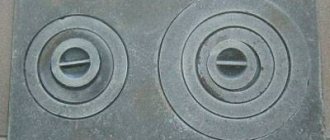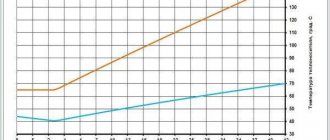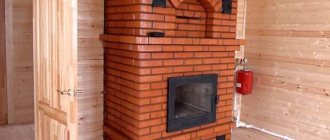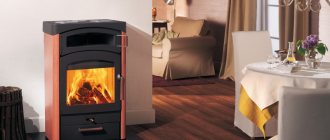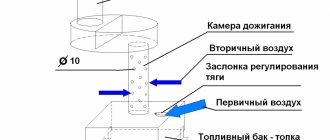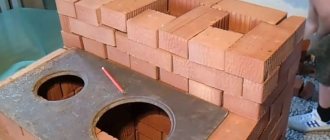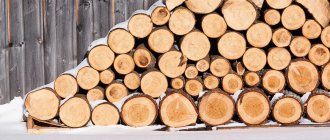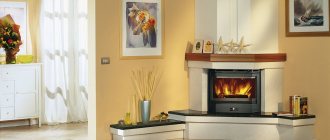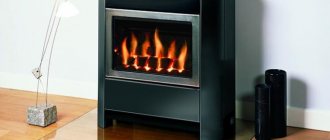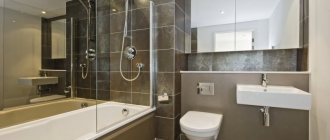Winter cold forces everyone to think about the issue of heating the room. There are several methods that differ in type of device, fuel, and efficiency. Just a few decades ago, in the countries of central Europe, the only method of heating was a fireplace. It continues to be a popular device today, but it is believed that its functions are reduced only to the fact of its very presence in the room, and the ability to heat the air in the room is only local in nature.
But the ideas of improving the classic fireplace made it possible back in that distant time not only to increase the efficiency of using the fireplace, but also to use it for heating a house consisting of several rooms. The created fireplace with air heating is one of the successful modifications of the classic fireplace, since it has a number of characteristic design additions.
The figure shows a diagram of the heat distribution around the fireplace
Mistakes when choosing an air-heated fireplace
The generally accepted scheme for selecting heating equipment is unacceptable in this case.
Most believe that the power of the firebox is adjusted to the area of the room at the rate of 1 kW per 10 m2. Time has shown that choosing a firebox for fireplaces for a country house with air heating requires an integrated approach. Gas stoves that are too powerful lead to overheating of the apartment. Residents have to open windows or reduce the amount of heating fuel they use. Frequent temperature fluctuations provoke colds and other unpleasant symptoms - weakness, dizziness and insomnia.
Fireplace area calculation table
How to calculate the required firebox power for an air-heated fireplace? Experts advise contacting sales consultants with this question. It is necessary to contact a specialist correctly, that is, by providing information on the area of the room, type of ventilation and number of rooms. Only in this case will the seller select the required power of the equipment.
Components
To understand the design of an air-heated fireplace, you need to understand the principle of convection energy transfer and the structure of the structure itself.
Components of the system
- The fireplace body is made in the form of a portal.
- closed firebox.
- A distribution unit in which air flows are redirected through channels.
- Air ducts, their role can be played by flexible pipes.
- Decorative grilles covering the places where air exits into the room.
Some features of self-designing a fireplace
The house design must necessarily include sections devoted to the construction of the fireplace and its individual elements.
Each fireplace has its own chimney above the firebox, the cross-sectional area of the chimney channel should be 1/10 of the firebox area. The distance from the junction of the chimney with the combustion duct must be at least 5 meters.
The chimney duct should be equipped with a special damper, which will separate the firebox from the chimney, and a hole designed to remove soot that accumulates during operation. The design of the gate valve can be retractable or fastening (using piano hinges).
Average fireplaces can weigh about 500 kilograms or more. Therefore, it is necessary to provide a sufficiently strong and reliable foundation under the fireplace.
If you are installing a fireplace in an already built house, you may need to carry out additional work to strengthen the load-bearing structures.
Air-heated fireplaces
Air heating of rooms and premises with a fireplace involves heating the air passing between the body of the firebox and its outer surface.
Diagram of a fireplace with air heating. Click to enlarge.
Heated air is distributed throughout the rooms of the house using pipeline channels installed in the walls or ceilings.
Aluminum or steel pipes are ideal for installing air channels.
In simpler schemes, a gravitational method is used to supply air, based on different densities of cold and warm air.
Fireplace air heating of this type does not depend on electrical energy, but it can be used to heat just a few rooms.
Fireplace air heating of a house with a large number of rooms and a pipeline length of more than 3 meters should be carried out according to a forced circulation scheme.
Such a scheme should include a pump that supplies air under the firebox body or above itself.
Forced air circulation can provide high-quality heating for a fairly large country house.
When choosing and installing such a circuit, you should remember that air exchange occurs in a closed cycle.
It is more rational to build a fireplace with air heating during the construction of the house, since otherwise you will be faced with tedious and very costly work - punching holes intended for laying air ducts.
Fireplaces with water mantle
The firebox of fireplaces with a water mantle has one significant structural difference - the body of the firebox consists of two layers, between which heated water circulates.
The fireplace in your room is not only an element of the interior, but also a source of heat.
Heated water is supplied to the radiators of the heating system using special pipelines.
The installation of a special heat exchanger (coil) in the upper part of the fireplace will provide the opportunity not only to heat the premises, but also to heat water for domestic purposes, the circulation of which will be carried out through special pumps.
Fireplace structure with water mantle. Click to enlarge.
Manual regulation of the operation of fireplaces is possible by increasing or decreasing the flow of air into the fireplace firebox. Automatic regulation is carried out through the operation of thermostats with which the pumps are equipped.
7196f3e665317c6c8bc3485445b7def9.jpe
ad128a56e9475981dd8e2bebc4210d60.jpe
Thermostats ensure automatic activation of the pumps after heating the water to the required temperature.
Self-installation
It should be immediately noted that all the work involved in organizing the construction of a fireplace with an air duct with your own hands is quite labor-intensive. In addition, the process is divided into stages, each of which has its own theoretical justification.
However, this does not mean that it is impossible to independently arrange such a fireplace. If you have ready-made projects and the necessary drawings, you can complete the entire installation efficiently and without significant errors, even with minimal experience in the furnace business.
Many professionals willingly share their experiences. It is recommended to use proven ideas from experienced craftsmen. A ready-made installation diagram for a corner air-heating fireplace will help the novice master at every stage, starting with laying the body itself.
Brick fireplace diagram
Choosing a location for the fireplace
The first preparatory stage is accompanied by the choice of installation location for the future fireplace. Despite the fact that there are many design options, in this case you will have to be guided solely by the practicality of the solution.
For high-quality heating of a house with a fireplace, it is necessary not only to provide the rooms with an air duct system, but also to optimize the length of the ducts. The shorter the length, the better the circulation will be. Therefore, the fireplace must be installed in a corner to utilize the maximum number of rooms.
In large houses it will not be possible to warm up all the rooms, and you will have to put up with this. But in standard layouts you can always find a room that borders on the maximum number of other rooms.
Convenient corner location
Construction of the foundation
In terms of weight, a fireplace with convection heating is practically no different from a classic fireplace. The foundation construction stage will also be similar. A pit is dug so that its depth is 60-70 cm. Depending on the chosen project, fireplaces can have a podium or a rectangular body, like English styles. This will affect the area of the foundation. Its boundaries should be several centimeters larger than the dimensions of the fireplace.
To fill the foundation you will need sand and crushed stone. But sometimes the pit is filled with concrete blocks. All this creates a reliable support for the fireplace. As a solution, you should use a masonry composition in a 1:4 ratio of cement and sand. The height of the foundation must correspond to the level of the floor covering. All other construction work must be suspended for the mortar to completely harden.
Wall masonry
Having made a layer of roofing felt on the foundation, you can begin laying the fireplace itself. To take into account the presence of all components and heater channels through which air will pass, the masonry should be carried out in separate rows according to a strictly defined pattern. This principle does not depend on work experience. Even professionals carry out similar actions with the difference that they remember many schemes by heart.
Direct construction of the fireplace
Some fireplace options include a brick firebox. But there are popular models in which a metal firebox in the form of a cassette is built into a brick portal. Measurements show that options with metal fireboxes have slightly higher efficiency than those with brick ones. However, the difference is so insignificant that everyone chooses the appropriate execution based on their own ability to pay.
Air duct installation
In the place where the air ducts pass through the walls of the room, the air temperature is not as high as in the firebox. But it is still necessary to provide for safety conditions. The contact points between the air duct and the finishing materials of the walls are insulated with mineral wool.
The main line itself is made of brick when building a house or from a flexible metal pipe. The master’s task is to thermally insulate this line so that the air retains energy for as long as possible during transportation. You can hide the air duct using a plasterboard box. To do this, a frame is made of a metal profile and sheathed with sheets of heat-resistant plasterboard. In some cases, air ducts are made inside the wall.
A well-installed heating system allows you to effectively heat the entire house using a fireplace, thus combining decorative qualities and technical capabilities.
Heating scheme
Heating of the house can be carried out using units of different categories. Intermittent burning fireplaces provide heat to the room for up to a quarter of a day with a single load of firewood.
Long-term burning devices with an equal amount of fuel increase this period to 8 hours. Even at minimum power, the volume of heat generated will vary from 3 to 6 kW. High heating levels are achieved with the air supply wide open. In this case, depending on the design, from 2 to 4 kilograms of firewood will burn per hour.
The power with which heating fireplaces will operate can be calculated based on the size of the heated room. In a room with a ceiling height of 2.8 meters, 1 kW of heat is enough to heat 10 m2 of area. Accordingly, with a power of 10 kW, such a furnace can serve 100 m2 of area.
Air
When energy moves from one medium to another, the amount of heat transferred is significantly reduced. A properly designed air-fired fireplace can solve this problem by reducing the number of thermal transitions. Its design involves burning fuel in a separate chamber, heating the metal part of the firebox and the air inside the room. Energy transfer is carried out using flexible thermally insulated channels connected to other parts of the residential building.
Air flows can move naturally or be adjusted in the desired direction by a forced injection system. With a vertical orientation, normal air flow is enough for high-quality heating. If the location of air-heated fireplaces is far from the rooms to which heat needs to be delivered, it is recommended to install special fans.
Vodyanoye
If the house has a conventional wood-burning unit, you can connect a heating system to it and achieve good results in terms of thermal efficiency. A water circuit is installed inside a fireplace of this design, connected to the general heating communications of the home. The combustion of wood in its firebox increases the temperature of the coolant in the pipes and due to this provides high-quality heating of the entire building. The two main connection schemes imply the operation of open and closed systems, respectively.
To install a fireplace in a house and connect open heating to it, you will need to hang an expansion tank above it, which works on the principle of communicating vessels. With a closed method of connecting the furnace, a common tank is used in the design, rather than a separate expansion tank being built in.
Boiler selection
The choice of a boiler for water heating at the dacha depends on the variety of energy sources available at the dacha.
If the dacha community has a gas main, then it is better to choose a gas boiler - this is the most economical option. Also, the boiler can be electric, or run on diesel fuel, or coal. It is worth paying attention to the fact that boilers can be single-circuit - intended only for heating the room, and double-circuit - coping not only with heating a country house, but also used for heating water
An example of a solid fuel heating boiler with a water circuit.
In a country house, the distribution of water heating pipes can be made open or hidden under the floor, which will help to install heated floors, which are very popular today. If the house is only at the construction stage, then it is preferable to place the heating system under the floor. And if the house is already ready, then the pipelines are installed along the internal walls.
Installation
Effective water heating in a country house can involve two types of piping:
with a vertical riser - all systems are connected to a single riser;
with horizontal drain.
The horizontal scheme is better than other options in terms of self-installation, and is cheaper to install, but there is a risk of air accumulation and the formation of air locks. The horizontal type is also used for installing warm water floors.
Chimney installation
After the “body” of the fireplace is ready, you can begin creating the chimney. Its passage must correspond to the calculated value. The top of the chimney should be reliably protected from precipitation. For these purposes, you should use a wide smoke hood made of galvanized sheet metal.
There is no better material for a chimney than red ceramic brick. Here's what one of our forum participants thinks about it.
The advantages of a brick chimney are considerable. It is much more difficult to achieve the formation of condensation in a brick pipe than in a sandwich - you have to try. The combustion of soot is not dangerous; the heating of the outer surface of the pipe in the attic is minimal or even completely unnoticeable. The durability of a properly laid brick pipe is many decades.
As a chimney, you can use a galvanized pipe made of heat-resistant steel. Such a chimney is made multi-layered (the result is a kind of “sandwich”), and it is covered with plasterboard on three sides.
During periods when the fireplace is inactive, any chimney becomes the cause of drafts. In order to avoid such a harmful phenomenon, special valves (gates) are installed in the chimney shaft. They open only when the firebox “comes to life”, filling the room with pleasant warmth.
The cross-sectional area of the cylindrical chimney with the area of the fuel portal should have a ratio of 1:10.
Particular attention should be paid to the height of the outer part of the chimney:
- if the distance from the ridge to the chimney is less than 1.5 m, then the chimney must be at least half a meter higher than the ridge;
- if the distance from the chimney to the ridge is more than 1.5 m, then the upper cut of the chimney should not be lower than the level of the ridge.
How to change air resistance.
It is necessary to approach the calculations of air ducts in an air heating system (AHV) at the stage of designing a house, when it is still possible to make changes to the design.
After the construction of interior partitions between rooms, you will no longer be able to change the traction force, because it is almost impossible to change either such an indicator as the temperature difference or the height difference. You will be able to slightly change only one parameter: resistance. Minimum resistance can be achieved only by maximizing the cross-section of the channels. However, this is not always possible in a ready-made house.
Advantages, disadvantages
The positive qualities of the units include:
- operating principle of a simple fireplace model: the release of thermal energy from the stove occurs during the process of fuel combustion;
- chimney ducts are designed to remove carbon monoxide. If you additionally provide channels through which air will move by convection, the temperature levels will become higher;
- there is no localization of heating zones near the fireplace;
- simplicity, lightness of the air circulation system of the coolant;
- high level of security. Compared to a water circuit, even the slightest hole in the pipeline can cause a break. Hot water can cause burns and severe harm to a person;
- lack of coolant;
- lightness, simplicity of turning on and off the heating;
- in comparison with a water circuit, significantly cheaper;
- no temperature differences across localization zones.
Negative sides:
- cost of organizing the system. Constant fuel supply;
- fuel cost.
Materials and design.
Fireplaces with a water circuit are made mainly from high-quality boiler steel, which has a guaranteed degree of heat resistance. Cast iron fireplaces with a water circuit are also produced, but such structures are quite heavy and require a separate reinforced foundation.
The design style of the fireplace portal can be almost any - classic, baroque, Victorian, modern. The decoration of the fireplace can be just as varied: natural or artificial stone, decorative brick and plaster, fire-resistant tiles. Some models of fireplaces with a water circuit have a special shape of the firebox, which allows cooking on a horizontal stove.
Advantages
Let's look at the main advantages of fireplaces with convection heating, and then move on to the device. Heating systems with air circulation have a whole list of advantages over a classic fireplace; we will highlight only the most significant of them.
Heat distribution diagram throughout the house
- Heat transfer by radiation stops completely when the fireplace is stopped. When a fireplace with a convection heating principle goes out, the air continues to circulate for some time, heating all the rooms. This fact contributes to fuel economy and increased efficiency.
- Due to the fact that air is used to heat the house, it is possible to increase the efficiency of the fireplace due to additional heat exchange not only in the firebox area, but also in the chimney.
- Air circulation implies the arrival of new portions from the outside. This provides additional ventilation in the room.
- Compared to water heating, where energy is transferred in two stages, an air heating circuit directly transports the coolant, which will fill the room.
- The presence of fans that participate in the circulation of the coolant increases the length of the channels with air ducts to 10 meters.
You need to think about the possibility of installing a fireplace when building walls. Firstly, it is easier to build a foundation for a fireplace when there is no floor covering yet, and secondly, the installation of air ducts requires partial destruction of the walls. During their construction, you can immediately equip the rooms with channels.
How does it work
To fully appreciate the effectiveness of a fireplace with an air circuit, you will have to consider the principle of heat transfer in a classic fireplace. As you know, there are three ways to transfer thermal energy. The thermal conductivity of air is quite low, so this method has never been considered as the dominant one.
The advantages of convection had not previously been objectively assessed, so the key bet was placed on radiation. A classic fireplace with an open firebox did not even heat the air in the room, but the surrounding objects, and they, in turn, transferred heat to the air and the room warmed up. However, it was impossible to even dream of transferring heat to other rooms.
Over time, the transfer of matter, as a method of transporting energy, became more and more of interest to furnace masters. Modern air heating from a fireplace is based on the fact that heated air is distributed throughout the rooms. The design of such a fireplace accomplishes two main tasks:
- efficient heating of air masses;
- their transmission over a distance.
Scheme of operation of the air heating system
The first task is helped by hollow channels that are installed in the fireplace body between the firebox and the outer wall. They can be made in the form of a labyrinth in order to increase the area of contact of air with the heated walls of the firebox.
The Russian stove in the chimney area is constructed in a similar way. Only tap heat transfer occurs from hot air to the walls. The air from below enters the channels through special holes and heats up. Convection currents move upward and as they move, the air temperature rises even more. Natural convection alone is not enough to move air through winding channels. It is necessary to use fans that pump in new portions of air and displace the heated masses that provide heating to the room.
The second task is achieved by distributing the air duct throughout the rooms. Warm air flows through the ducts into neighboring rooms. If the length of the air duct does not exceed 3 meters, then natural convection is used for transportation. Otherwise, forced circulation is ensured.
Construction of a classic brick fireplace
Strictly speaking, open hearths are not suitable for heating private cottages due to the low efficiency of burning wood, the efficiency is only 20-30%. While the fire is burning in the firebox, heat spreads throughout the room through infrared radiation. After attenuation, the heating intensity decreases and stops after 2-3 hours, when the brickwork has cooled.
Despite their low heat transfer rates, fireplaces remain attractive to homeowners because they create a unique homely atmosphere. The structure of a classic English hearth is shown in the diagram and includes the following elements:
- underground part - foundation;
- base of 2-3 rows of bricks;
- bottom part with a protruding pre-furnace platform;
- portal - brick frame of an open firebox;
- smoke collector - an umbrella-shaped channel tapering upward above the combustion chamber;
- the fireplace tooth at the beginning of the smoke collector serves for better heat extraction from hot gases;
- chimney pipe leading to the roof;
- the traction force is regulated by a valve.
Diagram of a classic open hearth
If the construction budget allows, then the outside walls are tiled, as was done above in the photo. It is not necessary to decorate the walls of the structure - the correct brickwork looks quite neat.
a7ab4a51a9a07018fb67959eed591a6c.jpe
This is interesting: Marble portals for fireplaces - we understand from all sides
Operating principle and design
The technical design is best made to order from a stove maker or a trusted company. The operating principle of an air-heated fireplace should be as follows. Cold air enters the firebox, where it is heated by the fire and enters the walls, from where, passing through the insulation box through the channels, it enters the facing casing of the metal chimney; it also releases heat. Having concentrated, warm air enters the room of the house through the grille in the cladding.
Principle of operation
Factory models of heating boilers for such fireplaces have a heat exchanger around the body in the form of a spiral or a radiator made of thin pipes through which water or air circulates. When heated, they flow through heating pipes to radiators in other rooms.
A fireplace with a water circuit using wood fuel has a low efficiency, not exceeding 60%. In addition, simple models require constant supply of firewood to effectively supply the house with heat. Pellet fireplaces are free from these problems. They use pellets as fuel, which have a higher specific heat of combustion than wood. The pellets are automatically loaded from the back of the firebox. You can regulate the flow rate and, therefore, the power of the fireplace using the electric control panel.
Fireplaces with ductwork can have an efficiency of up to 80%. Complex models can be designed with heating functions in the firebox and wall. This ensures maximum heating of the circulating air. Unlike water circuits, air systems require fans, which requires additional wiring and more power consumption. But the pipes for them are less demanding in terms of strength; most often they are made of thin and cheap aluminum.
For safety, most air and water fireplaces are equipped with a safety glass door. Heat penetrates into the room through this glass due to infrared radiation. This eliminates the possibility of sparks entering the room, and the owners can enjoy the view of a bright flame. To keep the glass shutter clean, it is protected from soot.
User reviews
Sergey: “I took the Kawmet W13 fireplace insert. It does not heat up externally, does not smoke, has a nice design and takes up little space. Power is 9 kW, but heat dissipation is high. It’s convenient to control the temperature using the oxygen supply regulator.”
Vlad: “Due to the small dimensions of the house, we had to choose the smallest fireplace insert, Uniflam 600. The system is equipped with a double back wall, an ash drawer and a deflector, and the air supply to the firebox can be adjusted. The model copes with its functions perfectly and looks harmonious against the background of my modest interior; it has become a real decoration of the house.”
Heating the room due to the heat transfer of the fireplace is optimal for a summer residence, since the device requires constant cleaning, preparation of firewood, and the use of additional heat sources at night. In country houses, fireplace heating serves as an auxiliary heating element in winter or during interruptions in central heating.
Air channels - device features
As with laying the firebox, brick or metal are used when installing the channels of the air supply system. You can also use special flexible pipes, which can be bought here, but they are recommended only for short sections, as they interfere with air movement. Failure to comply with this condition will require the installation of more powerful fans, which will increase the cost of your fireplace.
Don't forget about the thermal insulation of the channels. This will not only reduce heat loss, but also increase the safety of the entire structure. For high-quality air movement (minimizing air resistance):
- ensures the most even surface of the inner part of the channels;
- the number of bends in the system is reduced;
- straight channels of large diameter are laid;
- the fireplace and the air duct are connected by separate channels.
Thus, a fireplace with combined heating allows you to quickly heat the rooms of the house, has a simple design, is safe and has a low price. However, you will have to work a little in the field of cleaning the chimney and firebox, and take care of arranging the storage area for firewood.
Interesting solutions in the interior
A fireplace is not only a means of heating, but also an original solution for the interior.
- For the fireplace, you can select a separate wall, line it with stone and build in a hearth. This design will become the center of the living room. Tall windows will add light and space. You can hang a picture, a family portrait or a TV above the fireplace.
- A corner fireplace will gather a warm, friendly company around its fire. Opposite you can put armchairs or a sofa. A small coffee table would also fit perfectly here. To create a more romantic atmosphere, you can lay a soft carpet in front of the fireplace.
Features of the stove device
Fire brick dimensions
It has been proven above that air circulation is much more efficient than traditional fireplace heating. High efficiency indicators are maintained due to the special design of the stove. It is worth noting that gas fireplaces are not much different in the design of stoves.
A cassette fireplace is the most demanding design for the correct arrangement of the stove. To equip it, builders use only refractory bricks or metal structures made of cast iron.
Cast iron stoves are considered the most heat-intensive and efficient heating devices.
Fans are located above the stove. Practice has shown that heating a house with a fireplace depends on their reliability. Therefore, experts recommend choosing only fire-resistant fans if you plan to install them yourself.
As for decorative elements, their presence is optional for a private home. However, summer residents are actively buying fireboxes with decorative elements with glass doors, modern opening mechanisms, etc.
When choosing a stove for a fireplace in a country house, special attention should be paid to the power of the device, which can be determined in the technical data sheet. The power of the stove increases with its size
Experts have come to the conclusion that it is better to buy stoves 10-15% more powerful than the equipment requires.
Diagram of air heating in the fireplace
Separately, it is necessary to note the closed stove. The lockable design further increases the power of the entire structure due to the smoldering provided by the closed door. As a result, not only the power of the equipment increases, but also the savings in fuel consumption increases due to a decrease in air supply. Thus, a closed firebox is an effective and economical equipment for heating a room.
Choosing the power and brand of fireplace
To calculate the power of the fireplace, use the formula: 1 kW = 10 m². Many developers indicate the productivity of the device in m³. Based on the parameters of a private home, it is quite easy to determine the power of the fireplace. It is necessary to multiply the length, width and height of the room. The final value corresponds to the volume of the building and the productivity of the fireplace in m³.
Advice: when purchasing a fireplace for heating a home, cottage, or commercial premises, you should pay attention to the products of the proven ones, “Palasetti”, “Piazetta”.
Which is better: a fireplace with a water circuit or with air ducts?
This question cannot be answered unequivocally. The advantages and disadvantages of both systems are based on the characteristics of the heated room and the desired temperature conditions in the rooms.
Heating fireplaces with a water circuit have the following advantages:
- efficiency;
- low cost;
- the fireplace circuit is easily integrated into the existing heating system of the house;
- possibility of preparing hot water;
- low cost of equipment;
- low energy price.
A heating fireplace with a water circuit has disadvantages:
- low efficiency;
- the need for constant energy loading;
- manual mechanism for adjusting the intensity of work.
If we compare fireplaces with open and closed combustion chambers, the efficiency of the first is 20%, and the second is 70%.
An air-heated fireplace is the easiest to make with your own hands, because the equipment is not complicated. The layout of the air channels itself is also easy to organize. The room reaches the desired temperature within a few minutes.
Disadvantages of a fireplace heating system with air ducts:
- constant circulation of dust in the house due to the operation of fans (in the case of forced air circulation);
- increased noise level due to air movement through air ducts;
- the temperature in the room drops just as quickly as it rose after the fireplace went out;
- low efficiency;
- the need for manual control of the combustion reaction;
- the need for constant loading of energy into the firebox.
Heating a house with a fireplace with a water circuit and air ducts can be an excellent alternative source of heat, but not the main one. Such heating elements operate on inexpensive energy. But fireplaces can be afforded by those people who are not too lazy to constantly throw firewood into the firebox, control the intensity of their combustion and periodically clean the chimneys.
Design
The standard fireplace unit includes:
- fuel combustion chamber;
- portal;
- air duct connections that increase heating efficiency;
- fan, in case of forced circulation;
- filter;
- ventilation grates;
- pedestal base for the firebox.
The advantage of a fireplace is the organization of heating without connecting to a centralized mains. A well-equipped unit will warm up a large house.
Fireplace design
With combined heating
They talk about combined heating when the fireplace gives off heat not only by radiation from the flame, but also by heating the air inside it. If everything is clear with the heat from the flame, then what is meant by heating the air in the fireplace?
In this case, the air temperature increases in special channels located between the firebox cavity and the lining material of its walls. Warm air enters the room through ducts in the walls or ceiling. To avoid its mixing with combustion products, the latter are discharged through the chimney.
Heated air can enter the air ducts in the walls:
- By natural convection. It is achieved due to the difference in the density of cold air and warm air.
- Forced convection. In this case, air is forced into the channels using fans.
With the help of control systems, you can control the power of these fans and, as a result, the distribution of heat in the house.
The design of air ducts must be carried out while working on a house project. In this case, you can provide for a lot of nuances in the operation of the future fireplace, including the type of fuel used.
The efficiency of the air duct system is based on certain basics that are known only to specialists, and it is recommended that you contact them. Thus, the greatest efficiency from a fireplace can be achieved by installing a simple system of channels, its centralization.
Those who are concerned about the cleanliness of the air in their home should know that it is best to use supply air to operate the fireplace. Otherwise, the following unpleasant situation will arise: polluted air from the fireplace room will enter the heating system, and under the influence of high temperatures it will return back in an even worse condition.
Diagram of operation of a fireplace with air heating
Rules to follow during installation
There are not so many of these rules, but failure to comply with them can lead not only to ineffective operation of the fireplace, but also to other more dangerous consequences.
- The main fan must be selected and installed so that its noise does not interfere with comfort.
- For the same reason, the air duct pipes must be of round cross-section.
- The convection chamber must be made of galvanized iron and lined with plasterboard.
- It is impossible to include in the air heating system rooms in which autonomous ventilation is provided. Kitchen, bathroom. Counter currents can disrupt proper air circulation, which will lead to bad consequences in the form of unpleasant odors and high humidity.
- To ensure fire safety, it is necessary to construct a heat cutoff from the ceiling.
These nuances simply must be observed.
Project No. 1 – compact mini-fireplace
This hearth is suitable for heating a room of 16-20 m² in a country house or a small country house. Another option for using the structure is as an outdoor barbecue built in a garden gazebo. A special feature of the fireplace is the side convection channels that heat the air in the room. The size of the building is 102 x 51 cm.
To lay out a mini-fireplace, you will need the following materials:
- solid ceramic brick – 240 pcs. (chimney pipe is not taken into account);
- inspection door 24 x 14 cm – 1 pc.;
- cast iron grates 18 x 14 cm;
- valve 25 x 14 cm;
- stainless steel sheet 1 mm thick, size 500 x 1000 mm;
- sheet of black or galvanized metal, laid in front of the firebox, dimensions - 70 x 50 cm.
Sectional drawing of a mini-fireplace. Convection channel outlets are provided on the side walls
The mini-fireplace shown in the drawing is laid out in the following order:
- The first tier is solid. On the second, 3 air channels are laid - 2 side and one in the middle, located under the grate.
- On the third row, the bottom part and the grate nest are formed (made 5 mm wider than the product). Then the grill itself is installed.
- From the 4th to the 10th tiers a fireplace insert is built. On row V, 2 metal rods Ø5 mm are laid for mounting a stainless steel sheet.
- In the 10th row, the rear brick protrudes a quarter into the firebox, the side stones move outward by 40 mm. The width of the firebox in this place is 49 cm.
- The ends of the side stones of the 11th tier are filed at an angle of 28° to the vertical line. You will get the supporting platforms of the arched vault. 2 stones in the depths of the firebox are placed on edge.
- The vault is built from 9 stones, cut in the form of a trapezoid with base sizes of 65 and 52 mm, as indicated in the order. The circle radius is 51 cm.
- On the 12th tier, the formation of the vault is completed, the upper steel rods are installed and a stainless screen is installed.
- Tier 13-14 forms the outlet openings of the convection channels. An inspection door is installed here.
- 15th row - the ceiling is being built, 16-18 - the beginning of the chimney.
The master will tell you in detail the algorithm for laying a mini-fireplace in his video:
Installation details
The multifunctional system has proven itself not only as an eye-catching element of home decor, but also as a useful item for household needs. A fireplace with a closed firebox accumulates heat, stores it and releases it into the room through special channels. With such a heating system, the efficiency of the fireplace reaches 80%. Units with an air duct, according to research, are much more economical and efficient, which is certainly better for a home, especially if it has several rooms.
So, the air in such a fireplace is heated in several places at once - in the firebox and the wall. To avoid heat loss when building a fireplace with your own hands, it is necessary to contact a stove maker at the project stage for consultation and correction of errors. It is more convenient, of course, to design a fireplace while building a house, since you need to take care of the foundation, the system of air ducts and pipes that will connect several rooms, and for this you will have to break the integrity of the walls.
Increased efficiency can be achieved by centralizing the system, in which case it is necessary to minimize the network of channels and pipes. If the length of the pipes is no more than 3 meters, then if installed correctly, forced circulation may not be necessary. Pipes made of aluminum or steel are suitable for installing air channels.
Project No. 2 - simple heating fireplace
The dimensions of this structure are 112 x 65 cm, height – 2022 mm. The internal size of the portal is 52 x 49 cm. Accelerated heating of the room is provided due to the convective air channel. The set of building materials looks like this:
- clay solid brick – 345 pcs.;
- the valve used in the chimney is 250 x 130 mm;
- 2 steel equal angle corners 45 mm wide and 70 cm long;
- metal sheet 500 x 700 mm.
The peculiarity of the masonry of the fireplace shown in the diagram is the placement of a large number of bricks at the base on an edge. Above, a narrow long channel is arranged where the heated air of the room moves. Let's move on to the construction algorithm:
- The first tier is solid, consisting of bricks placed “on the butt”. On the second tier, a heating channel with a cross-section of 65 mm is formed, on the third, the base of the firebox is laid.
- From the 4th to the 9th rows the portal walls are erected. The duct moves inside the back wall of the fireplace. On the 9th tier, corners are placed - floor supports.
- Tier No. 10 – firebox overlap. On the 11th row, the front stones extend 130 mm, the 12th tier is a fireplace mantel. The convective channel is divided into 2 narrow shafts.
- Rows 13-25 make up the smoke box. The heating channel ends at the 14th tier.
- Row No. 26 covers the flue, which narrows to the chimney. The valve is installed on the 27th tier.
- The remaining rows 28-31 form the beginning of the chimney.
The test fireplace lighting technique is demonstrated in the latest video:
Requirements for stove heating
Traditional stove design
A traditional stove is a brick structure that has a firebox, an ash pan and a flue system. The latter played an important role, since the heating of the house occurred due to the heat of carbon monoxide, which passed through a complex system of channels.
However, for houses with a large area this scheme is not effective. Therefore, they prefer to do water heating from a stove with their own hands. To do this, a heat exchanger is installed in the firebox to heat the coolant - water, air or to generate steam. This scheme will increase the heating efficiency and significantly increase the heating area in the house.
- It is recommended that the stove is not located against a load-bearing wall so that a system of chimney ducts can be arranged;
- The material used to make the floor and walls in the area of the stove must be non-flammable;
- Mandatory installation of a protective door in the ash pit and firebox;
- Drawing up a schedule for cleaning the chimney from soot and soot. This procedure should be carried out at least once every 2 months and before each heating season.
How to build a water heating stove with your own hands? First you need to choose the optimal design that will meet the requirements of a particular home. There are many construction schemes - from the simplest designs to complex ones with sun loungers and ovens.
The height of the stove chimney should not be less than 4 m. Otherwise, due to the high temperature of carbon monoxide, condensation will accumulate on its surface, which will inevitably fall into the combustion chamber.
Masonry
Scheme for laying rows for a corner fireplaceOrdering an English fireplace
Cover the dried foundation with a double layer of roofing material. This will provide the necessary protection for the base.
Prepare mortar for brickwork. Traditionally, fireplaces are laid using a solution based on pre-soaked clay.
Laying the first row is best done using mortar with a small addition of cement (approximately 10-20% of the total mass of the mixture).
Calibrate the bricks in advance, selecting the most suitable sized products for laying each row.
Before starting laying, immerse the bricks in water for a while. This will allow the products to become saturated with moisture. Otherwise, the bricks will take water from the clay mortar, which will lead to a significant deterioration in the quality of the masonry.
Lay out the first row of bricks edgewise. Check that the row is laid out correctly with a square and level. Make sure the opposite sides and diagonals of the base are the same length.
The recommended thickness of seams is up to 0.5 cm.
The masonry is carried out in accordance with the order. The following will be a procedure that is relevant for most existing types of fireplaces. For the rest, rely on the drawings you have.
Laying a fireplace, step-by-step instructions
Lay out three continuous rows of the base.
Laying a fireplace, step-by-step instructions
Second step
Lay out 4-5 rows with an ash pan.
Fireplace laying, step-by-step instructionsFireplace laying, step-by-step instructions
Third step
Lay out 6-7 rows with the arrangement of the bottom and frame of the brick fireplace.
Laying a fireplace, step-by-step instructions Laying a fireplace, step-by-step instructions Laying a fireplace, step-by-step instructions Laying a fireplace, step-by-step instructions Laying a fireplace, step-by-step instructions Laying a fireplace, step-by-step instructions Circle and formwork for laying an arch subfloor Laying a fireplace, step-by-step instructions Laying a fireplace, step-by-step instructions Laying a fireplace, step-by-step instructions
Fifth step
Lay out rows 14-19 with a smoke collector.
Laying a fireplace, step-by-step instructions Laying a fireplace, step-by-step instructions Laying a fireplace, step-by-step instructions Laying a fireplace, step-by-step instructions Laying a fireplace, step-by-step instructions
Sixth step
Lay out 20-25 rows of the fireplace with a chimney arrangement.
Arrange the base and continuous rows of masonry using a trowel or trowel. The chimney and fuel chamber are laid out manually, because
at these stages it is very important to control the quality of the solution used
Apply fireplace mortar to the middle of the bricks. The edges of the elements must remain free.
When laying out each row, adhere to the chosen order. For greater convenience, you can number the products.
Pay special attention to the quality of the masonry of the fuel compartment and smoke exhaust ducts - these elements must be laid out as evenly as possible and as airtight as possible. Laying a fireplace, step-by-step instructions Laying a fireplace, step-by-step instructions Laying a fireplace, step-by-step instructions Laying a fireplace, step-by-step instructions Laying a fireplace, step-by-step instructions
Laying a fireplace, step-by-step instructions Laying a fireplace, step-by-step instructions Laying a fireplace, step-by-step instructions Laying a fireplace, step-by-step instructions Laying a fireplace, step-by-step instructions
To form a beautiful curved fireplace vault, apply a gradual overlap of masonry elements
It is important that the overlap size does not exceed 50-60 mm in each row
The construction of curved lintels is carried out using temporary formwork - circles. To fix such formwork, use supports under the fireplace vault being installed.
Start laying from the brick installed in the center, and then carry out symmetrical laying in both directions.
Periodically check the verticality of the smoke exhaust pipe. Even the slightest deviations from the vertical can lead to smoke in the room.
Laying a fireplace, step-by-step instructions
To lay the chimney, use a mortar with added cement, similar to the mixture used when laying out the fireplace base.
The smoke exhaust pipe must be covered with a layer of fire-resistant insulation to increase fire safety. Insulation is installed where pipes pass through the structure of the house (floors, roofing, etc.). The most commonly used insulation materials are asbestos based.
Fireplace chimney
Which channels have the least resistance?
Round straight air ducts of sufficiently large diameter have low resistance. Slightly higher resistance is typical for straight rectangular channels. Greater resistance is caused in narrow channels laid with a large number of bends and narrowings.
For the proper functioning of air heating systems from the fireplace, you need to choose
| round air ducts Ø100, 125, 150mm | rectangular size 50x150mm |
It must be remembered that in a gravitational system no branches are allowed in the channels. Each of the air ducts cannot extend to the side by more than 4 m. To avoid excessive resistance, it is necessary to install grilles with the largest area at the ends of the ducts.
Types of fireplaces by material of manufacture
To construct aqua fireplaces, brick, natural stone, ceramics, cast iron, steel sheet, basalt fiber insulation, and heat-resistant glass are used.
Brick
The fireplace stove can be custom-designed to almost any configuration. Finishing with tiles will emphasize the individuality of the interior. As a rule, high-quality working bricks (refractory) are used in such fireplaces.
Requires careful adherence to technology and high-quality installation. Installed on a separate foundation. The high starting cost is justified by the increased comfort.
Metal
The most profitable due to the optimal price/quality ratio. Light weight, affordable price, simple installation, and varied designs contribute to their widespread distribution.
Combined
They combine the comfort of infrared fireplace heating, the heat capacity of a massive stove, and the functionality of a water heating system. They have the highest possible efficiency. They release accumulated heat for a long time after the fire goes out.
A combustion chamber with a heat exchanger is built in during the construction of a brick or stone fireplace facade. Since access for repairs will be difficult later, the cast iron option is optimal. A separate foundation is required, so it is recommended to use a durable ceramic chimney.
Selecting a convector
How to choose a gas convector? First of all, attention is drawn to the technical characteristics of the unit. The best option is a device with a closed combustion chamber and a cast iron heat exchanger. The presence of a programmable control unit is considered important
Let's look at other factors that you should pay attention to when choosing a household gas convector
The presence of a programmable control unit is considered important
Let's look at other factors that you should pay attention to when choosing a household gas convector
Device power
Since heating occurs due to air circulation, the units operate effectively in only one room. Therefore, each room will require the installation of a separate unit. Power is determined from the calculation: 100 W are required per 1 m 2 of area.
Heat exchanger material
Since gas heating convectors operate on gas, which burns in a special chamber, the heat exchanger is exposed to strong temperature effects. If it burns out after some time, the device fails. Therefore, the material of this part must be resistant to high temperatures. The leader among heat exchanger materials is cast iron. This metal is resistant to thermal stress; in addition, it cools very slowly and distributes heat evenly. Gas convectors with a cast iron heat exchanger can last up to 50 years. The main disadvantages of such devices are the high price and large mass of the unit. A heater with a steel heat exchanger is cheaper and lighter
But when choosing a unit, you should pay attention to the quality of the steel. Steel heat exchangers can last at least 20 years
Combustion chamber type
Heaters may differ in design based on the type of combustion chambers:
- Open
combustion chamber. Installation of a unit with such a chamber requires the installation of a chimney with access to the roof. In addition, when the unit is operating, air will be taken from the room to maintain the combustion process. Therefore, good ventilation of the room is required. - Closed
combustion chamber. Such models are more popular because they do not require a pipe outlet through the roof (a coaxial pipe is installed opposite the device). And another advantage is that the oxygen in the room is not burned, since the air is taken from outside the building.
Availability of a fan
A gas convector with a fan quickly and evenly heats the entire room. Due to the forced air supply to the heat exchanger, the latter is cooled better. And since overheating is prevented, the service life of the heat exchanger is significantly increased.
Room type
If you want to install a convector in an apartment
, then the best choice would be a device with a closed combustion chamber and a chimney with a coaxial pipe. This type of device does not burn oxygen in the room. In private buildings
you can install any. But when using a device with an open combustion chamber, the room must have fresh ventilation.
Type of fuel
The use of liquefied gas is prohibited in apartment buildings. Therefore, the device is connected only to the main line
. In private homes, use a gas convector using bottled gas
possible, provided that the cylinder is installed outdoors in a special metal cabinet.
Amount of fuel consumed
Fuel consumption in gas heating equipment is considered economical. To calculate gas consumption, the following basic parameters are accepted:
- 1 kW of power will require 0.11 m 3 of gas from the main;
- 1 kW of power will require 0.09 m 3 of liquefied gas.
Based on these indicators, you can make a calculation. For example, a 4 kW heater (designed for 40 m 2 of area) will consume 0.44 m 3 of gas per hour of operation, and 10.56 m 3 per day. But, since the device does not work constantly, this figure will be significantly less.
Determination of basic dimensions
The ratio of the size of the fireplace and the room
Perform the necessary preliminary calculations. Determine the volume of the room allocated for the construction of the fireplace. The firebox opening should be 1/50 of the room volume you calculated.
The height of the portal should be 2 times the depth of the firebox.
The dimensions and ratios given are very important. If the depth of the firebox is greater than the permissible value, the fireplace will significantly lose heat output. With a smaller firebox size, smoke will occur.
Select the dimensions of the smoke openings taking into account the dimensions of the combustion area. The cross-sectional area of the chimney should be 10-15 times smaller than the area of the firebox.
The optimal diameter of round chimneys is 100-150 mm. The length of the smoke exhaust pipe can reach 500 cm or more.
What does air movement depend on?
The movement of warm air through air ducts is accompanied by a certain resistance. In order for air to move independently (gravitational), it needs to overcome this resistance due to traction.
The traction force indicator depends on the difference in height and temperature difference at the inlet and outlet of the channel. The resistance depends on the diameter of the channel. That is, the greater the temperature difference, height difference and pipe diameter, the greater the traction force will be. Conversely, in long, thin pipelines with a complex network, the resistance will be greatest.
So, in those cases where resistance prevails over the traction force, the hot air will not be able to move forward on its own and will not reach the end point.
Which system will give the advantage: gravitational or primus.
A gravity system should be considered for heating relatively small one- or two-story houses. It is recommended to place the fireplace closer to the center of the house. Thanks to this, the thermal channels will be short and approximately the same length.
If the house is quite large, and there is no opportunity to place the fireplace in the center, then you will not be able to reduce the length of the channels to the minimum acceptable size. The only solution in this situation is to install a fireplace fan. A system using a fan allows you to heat both remote rooms and rooms that are located at a lower level from the fireplace.
Which ducts to choose: round or rectangular, insulated or single-walled
Of course, the least resistance is characteristic of round pipes. Therefore, they are best suited for air heating. They are flexible and easy to install
However, it is not always possible to use thermocorrugation. For example, a round air duct is more difficult to hide above a suspended ceiling or in the floor covering, so in these situations a rectangular pipe is chosen.
Most often, installation is carried out using a combined method: both round and rectangular pipes are used, which are connected to each other by adapters (reductions).
- Fireplace with warm air distribution
Fireplace with warm air distribution - Fireplace insert with heat distribution
Fireplace insert with heat distribution
As for the question of whether it is worth insulating pipes, there is a clear answer - yes. All ducts that exit the fireplace's heat chamber (not the distributor) must be insulated. Our goal: to bring warm air to the final point, exactly where we need it, and not to heat the walls of the house. Insulation also prevents excess noise from entering.
- Duct insulation
Duct insulation - Heat duct insulation
Heat duct insulation
We recommend conducting warm air from the distributor to the decompression chamber (in the space of the main thermal chamber) using non-insulated flexible aluminum pipes.
Why not insulated? Very often we want to heat many rooms from the fireplace insert, so there will be a lot of air ducts coming from the distributor (sometimes as many as six). Taking into account that there will be a large number of them, and the surface of the distributor is limited, they will be located quite tightly. At the same time, they can touch both each other and the hot chimney channel, which also passes through this chamber. If you touch the chimney, the insulated pipe may melt from the outside. By using an uninsulated pipe in the heat chamber, you can prevent the effect of melting the external insulation.
- Fireplace box
Fireplace - Fireplace pipes
Fireplace pipes
| So, in vertical areas, attics, technical rooms, where there is no need to hide them, we use a round insulated pipe. Please note: when using flexible pipes, you need to ensure that they are well stretched (to avoid unnecessary resistance). On horizontal sections that will be hidden by a suspended or suspended ceiling or floor covering, we use a rectangular insulated air duct. We conduct air through the thermal chamber with an uninsulated flexible round pipe. |
Is it possible to install a fan if the gravity system does not work efficiently?
Clients often ask us whether it is possible to connect a fan to air ducts separated by gravity. It is possible, but it is quite difficult to do.
The gravity system differs from the forced one in that in the first case several channels depart from the fireplace (one for each room), in the second there is one pipeline that goes to the fan, and from it the air branches out throughout the rooms. Therefore, it is possible to change the system, but to do this you will need to disassemble the upper part of the cladding and replace some of the pipes.
Choosing a home fireplace is a rather difficult and serious task that must be approached with all responsibility. Today, fireplace inserts are quite widely represented in relevant online stores, but the price of fireplace inserts is either unreasonably high or suspiciously low. That is why our online store “Energy Saving Systems” provides you with the opportunity to buy fireplace inserts at a fair...
Choosing a home fireplace is a rather difficult and serious task that must be approached with all responsibility. Today, fireplace inserts are quite widely represented in relevant online stores, but the price of fireplace inserts is either unreasonably high or suspiciously low. That is why our online store “Energy Saving Systems” provides you with the opportunity to buy fireplace inserts with a fair price/quality ratio, at the manufacturer’s price. Our website presents products from the world's best companies with a wide range of power and efficiency.
Who visits our online store?
- People who are confident that home heating costs need to be significantly reduced.
- Those who want to buy a fireplace so that it can bring not only aesthetic pleasure, but also allow them to save money.
- Owners of an open fireplace that does not produce the desired results.
- Home owners who don’t know where to start arranging a heating fireplace.
- Those who wish to order the service of professional installation of a room heating system with a fireplace.
You can buy fireplace inserts for heating in an online store without any hassle or doubt, because it is extremely easy to do. Our managers are always ready to give comprehensive answers to questions that arise from clients. We offer not only to order a fireplace insert in our online store, but also to purchase a fireplace by visiting one of the showrooms in Lviv and Kyiv. In any case, you will be able to receive qualified advice and important recommendations on choosing the appropriate option.
Fireplaces and fireplace inserts for heating – features of selection and application:
When choosing a fireplace, you should understand that it is primarily a heating device. That is why its acquisition should be taken with the utmost seriousness. It is important to consider the technical capabilities, purpose and design features of the models you choose. You also need to remember that fireplace inserts from different manufacturers differ significantly from each other in precisely these indicators. Despite this, externally, fireplace inserts can be very similar.
How to reduce home heating costs?
Fireplace inserts can perform the function of heating equipment: be both the main and auxiliary source of heating in the house. But not every fireplace insert can heat a house. Fireplace inserts can be either for decorative purposes (with intermittent combustion) or with a heating function (continuous combustion).
Two types of functional fireplace inserts will help you save on heating your home:
- – with air heating;
- – with water heating.
To heat a water heating system, you need to buy a fireplace with a water circuit. It will perform the work of a solid fuel boiler and fireplace at the same time. Most often, a water fireplace is used in a system with another heat source, for example, a gas or electric boiler. When the fireplace is operating, the other source is automatically switched off. A fireplace with a water circuit can also independently heat the entire house. This saves money on heating your home.
The efficiency of a fireplace-based air heating system depends on many factors:
A very important indicator is the material used to make the firebox and the thickness of its walls. If it is a cast iron firebox, then it is desirable that it be monolithic. The material must comply with European standards EN – GJL – 200-250. Poor quality material and thin walls will not retain heat, and constant temperature loads can lead to rapid burning of the walls. A fireplace insert for air heating must be designed to operate in a continuous, long-term combustion mode. Only in this case will you get the desired result. The air-heated fireplaces and stoves we offer will provide you with affordable heat and independence from other energy sources.
If it is not possible to install a traditional wood-burning fireplace, and the dream of home comfort with a fireplace does not leave you, we suggest buying an electric fireplace with a 3D flame effect. For country houses or cold rooms, free-standing fireplaces and stoves that do not need finishing are ideal. We can also offer you stoves for baths and saunas.
To purchase a fireplace and order its installation:
You can send us a house plan by email, or order a visit from our specialist to take measurements on site. We will make you a free commercial offer for a fireplace heating system, which will indicate all the necessary equipment.
A good fireplace can really heat up your home quickly. You won't turn your beautiful living room into a boiler room, since you won't have to add wood to the fireplace every hour. Our fireplace inserts allow one load of wood to burn for a long time, even up to 12 hours.
You can buy fireplaces, fireplace inserts in Ukraine or other products presented by us by ordering them by phone or through an online store. In all cities of Ukraine we deliver by transport service.
